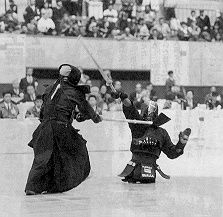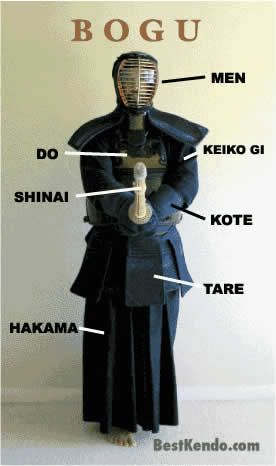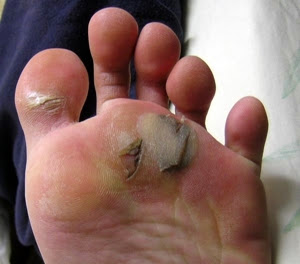
This study guide is from AUSKF website
http://www.auskf.info/docs/studyguide.htm
KATA
The failure of most candidates kata at lower dan is the lack of practice, the mechanics should be just rote memory. It is very obvious which candidates have neglected kata for long periods of time, hurriedly preparing by practicing only a few times before their test. Logically one would expect that if kata is 50% of the test the candidate would put more effort in to the practice and the learning of kata.
The uchidachi must demonstrate a strong leading of the shitachi, while the shitachi must be able to read the uchidachiís intention. A kodansha performing kata must express a strong and true spirit, reasonable mind and balanced zanshin. The performance shows stroke with drive and spirit, ri-ai, ma-ai, and understands the rhythm of each of the 10 forms.
Starting at 1st-Kyu where just the basic mechanics are needed to Sandan where all the mechanics and the basic fundamentals previously discussed are required, the kata of the candidate should improve at each dan level. At Yondan the kata must demonstrate a better understanding of the hei-ho of Kendo, the rhythm, seme and zanshin. All these things must steadily improve at each succeeding level.
Points that are observed when grading by the examiners:
-Manner before and after the tachi-ai.
-Does the candidate understand all five kamae in 1 through 7 and han-mi and iri-mi in the kodachi kata?
-Does the candidate demonstrate an understanding of me-tsuke and breath control matching with the partner?
-Does the candidate demonstrate an attitude of reality and dignity for the rank requested?
-Does the candidate demonstrate the relationship between uchidachi and shitachi in movement and rhythm?
-Is the timing of the strikes correct, is the shitachi receiving correctly?
Is the ma-ai correct?
-Is the strike with mono-uchi?
-Are the basic mechanics of the strikes correct? Not too big or too small.
-Is the footwork sliding or just walking? Are the heels touching the ground, flatfooted?
-Does the shitachi demonstrate ki-gurai and does the uchidachi respond to the shitachi's zanshin?
Expectations of Rank
6th-kyu through 2nd-kyu can be awarded at the dojo level depending on the regional federation. Other federations formally test for these grades and some have age restrictions for children. 1st-kyu and above are done through the formal examination process. While it is normal to have both adults and children testing for the same level of kyu there can be a great deal of difference in the basic skills between the adults and children. Most often the children have been doing Kendo much longer and have much better basics than the adults. However when the mental maturity of the adults is factored in this should not be a problem. An experienced examiner will understand this kind of situation and grade accordingly. (see attachments for skill guidelines used by some regionals)
1st-kyu requirements: enter and leave the court properly, strike with ki-ken-tai-ichi, good energy and 1 or 2 yuko-datotsu.
Shodan: same as above with nidan waza included.
Nidan: demonstrate the use of shikake waza, harai waza, debana waza, hiki waza, and oji (oh-ji) waza. Obviously the occasion may not arise to use most of the mentioned waza, but the candidate should show better basics than the Shodan level and be able to use more advanced technique as above. The Kenshi at this level should not be obsessed with the use of waza but start to master the opportunity of attack. Cuts should have good vertical motion with the use of both hands and te-no-uchi.
Sandan: Use seme and ken-sen to initiate attacks and have sharp waza. Particularly the use of oji type of waza should be incorporated in the candidates Kendo.
Yondan: should display very solid Kendo and kamae, display mastery of a variety of techniques, yuko-datotsu, excellent footwork and posture. An attacking kamae full of spiritual energy should be displayed rather than a waiting kamae that reacts to the opponent.
Godan: starting with the Godan examination the candidate must truly exhibit the use of seme and ken-sen to create the moment of attack. Often failure is caused by the candidate doing shiai style of keiko and trying to win points. One must demonstrate the control of the center, the opponents spirit, and mastery of the footwork and shinai. The Kendo must be logical without unnecessary strikes and actions. The strike is followed by zanshin that is true mental alertness.
Rokudan: the same as Godan, but even more, the ri-ai must be demonstrated. Strong control of the center, efficient use of waza and footwork, mental control of the opponent and situation.
Nanadan: all aspects of the previous ranks must be present and an essence of dignity that speaks to quality Kendo. This dignity shows both on and off the court in the persons life.
Kodansha Kendo is not only just winning a strong shiai, strong keiko or beating an opponent in the shinsa. You must express your Kendo with the correct kamae, strong ken-sen, reasonable ma-ai, smooth flowing footwork, body movement and a strong, smooth stroke in your strikes. This must be performed in one rhythm with sharp te-no-uchi.
Check following AUSKF website for the Written Exam
http://www.auskf.info/docs/studyguide.htm
Kirikaeshi
3 Different Ma-ai
Metsuke or enzan-no-metsuke
Ki-ken-tai-itchi
Zanshin
Seme
Mittsu-no-sen or the three attacks. According to Miyamoto Musashi there are three sen:
Kill the sword or ken-o-korosu
All these methods lead to the four sicknesses;
footwork. Ashi-sabaki or footwork is broken down into four types:
Waza









